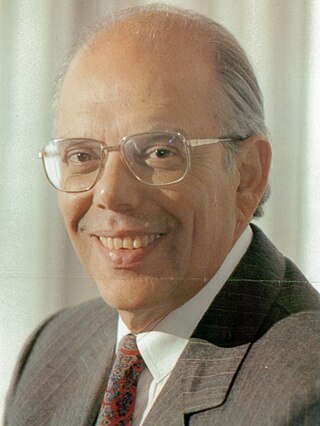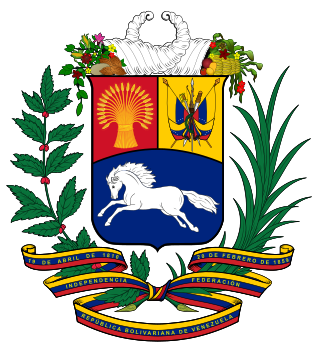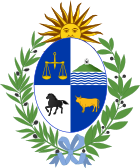The history of Uruguay comprises different periods: the pre-Columbian time or early history, the Colonial Period (1516–1811), the Period of Nation-Building (1811–1830), and the history of Uruguay as an independent country (1830–present).

The politics of Uruguay abide by a presidential representative democratic republic, under which the president of Uruguay is both the head of state and the head of government, as well as a multiform party system. The president exercises executive power and legislative power and is vested in the two chambers of the General Assembly of Uruguay. The Judiciary is independent from the executive and legislature.

Jorge Luis Batlle Ibáñez was a Uruguayan politician and lawyer, who served as the 38th president of Uruguay from 2000 to 2005. A member of the Colorado Party, he previously served as National Representative from 1959 to 1967, and as Senator of the Republic from 1985 to 1990 and from 1990 to 1999.

José Pablo Torcuato Batlle y Ordóñez, nicknamed Don Pepe, was a prominent Uruguayan politician who served two terms as President of Uruguay for the Colorado Party. Born in Montevideo, he was the son of a former president and was widely praised for the introduction of his political system, Batllism, to South America and for his role in modernizing Uruguay through his creation of extensive welfare state reforms.

The Constitution of the Bolivarian Republic of Venezuela is the current and twenty-sixth constitution of Venezuela. It was drafted in mid-1999 by a constituent assembly that had been created by popular referendum. Adopted in December 1999, it replaced the 1961 Constitution, the longest-serving in Venezuelan history. It was primarily promoted by then President of Venezuela Hugo Chávez and thereafter received strong backing from diverse sectors, including figures involved in promulgating the 1961 constitution such as Luis Miquilena and Carlos Andrés Pérez. Chávez and his followers (chavistas) refer to the 1999 document as the "Constitución Bolivariana" because they assert that it is ideologically descended from the thinking and political philosophy of Simón Bolívar and Bolivarianism.

Feliciano Alberto Viera Borges was a Uruguayan political figure.

The Constitution of Uruguay is the supreme law of Uruguay. Its first version was written in 1830 and its last amendment was made in 2004.

The National Council of Government was the ruling body in Uruguay between 1952 and 1967. It consisted of nine members, of which six were from the party that received the most votes in general elections, and three from the runner-up party. Generally known as the colegiado system, it had previously existed as the National Council of Administration between 1918 and 1933.

The civic-military dictatorship of Uruguay (1973–85), also known as the Uruguayan Dictatorship, was an authoritarian military dictatorship that ruled Uruguay for 12 years, from June 27, 1973 until March 1, 1985. The dictatorship has been the subject of much controversy due to its violations of human rights, use of torture, and the unexplained disappearances of many Uruguayans. The term "civic-military" refers to the military regime's relatively gradual usurpation of power from civilian presidents who continued to serve as head of state, which distinguished it from dictatorships in other South American countries in which senior military officers immediately seized power and directly served as head of state.

A constitutional referendum was held in Uruguay on 29 November 1942, alongside general elections. The new constitution was approved by 77% of voters.

A constitutional referendum was held in Uruguay on 30 November 1980. Although the new constitution drafted by the military regime was rejected by voters, some of its proposals were implemented anyway.

A constitutional referendum was held in Uruguay on 24 November 1946, alongside general elections. Two options for amending the constitution were put to voters, but both were rejected.

A constitutional referendum was held in Uruguay on 16 December 1951. The proposed amendments to the constitution were approved by 54% of voters.

A constitutional referendum was held in Uruguay on 27 November 1966 alongside general elections. Four proposals for amending the constitution were put to voters, with one option receiving 65% of the vote. As a result, the colegiado system was abolished in favour of returning to the presidential system.

The first Constitution of Uruguay dates back to 1830. Drafted by the Constituent Assembly, summoned in the Church of La Aguada in 1829, it was sworn by the citizens on 18 July 1830.

The sixth Constitution of Uruguay came into force in 1967.

The fifth Constitution of Uruguay was in force between 1952 and 1967.

The third Constitution of Uruguay was in force between 1934 and 1942.

The second Constitution of Uruguay was in force during the period 1918–1933.

The National Council of Administration was part of the executive power in Uruguay between 1919 and 1933, ruling alongside the President of the Republic.







